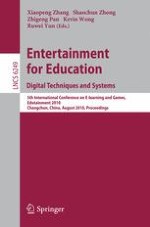With the technical advancement of digital media and the medium of communication in recent years, there is a widespread interest in digital entertainment. An emerging te- nical research area edutainment, or educational entertainment, has been accepted as education using digital entertainment. Edutainment has been recognized as an eff- tive way of learning using modern digital media tools, like computers, games, mobile phones, televisions, or other virtual reality applications, which emphasizes the use of entertainment with application to the education domain. The Edutainment conference series was established in 2006 and subsequently - ganized as a special event for researchers working in this new interest area of e-learning and digital entertainment. The main purpose of Edutainment conferences is to facilitate the discussion, presentation, and information exchange of the scientific and technological development in the new community. The Edutainment conference series becomes a valuable opportunity for researchers, engineers, and graduate s- dents to communicate at these international annual events. The conference series - cludes plenary invited talks, workshops, tutorials, paper presentation tracks, and panel discussions. The Edutainment conference series was initiated in Hangzhou, China in 2006. Following the success of the first event, the second (Edutainment 2007 in Hong Kong, China), third (Edutainment 2008 in Nanjing, China), and fourth editions (Edutainment 2009 in Banff, Canada) were organized. Edutainment 2010 was held during August 16–18, 2010 in Changchun, China. Two workshops were jointly org- ized together with Edutainment 2010.
